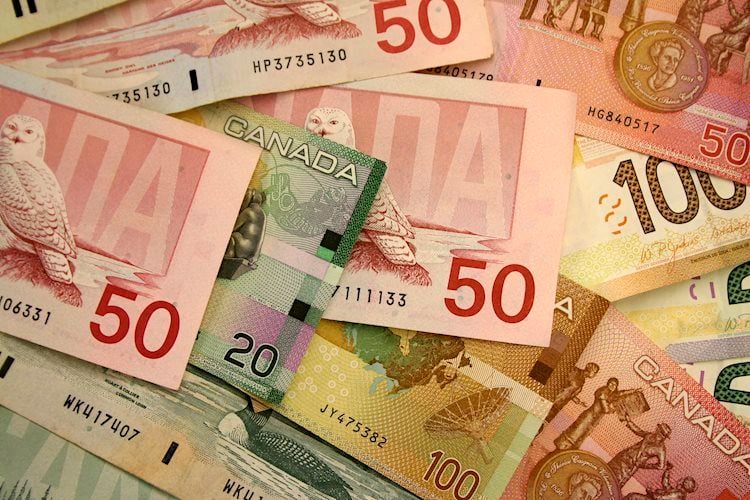Products You May Like
- USD/CAD witnessed some profit-taking after touching a fresh multi-year high on Thursday.
- The fundamental backdrop warrants some caution before positioning for deeper losses.
- Traders now look to the final US Q3 GDP and Jobless Claims data for short-term impetus.
The USD/CAD pair retreats slightly after touching its highest level since March 2020, around the 1.4465 region during the Asian session on Thursday and for now, seems to have snapped a five-day winning streak. Spot prices currently trade near the 1.4430 area, or the daily low, though any meaningful corrective decline seems elusive.
The US Dollar (USD) enters a bullish consolidation phase following the previous day’s post-FOMC spike to a two-year high and prompts some profit-taking around the USD/CAD pair amid overbought conditions on the daily chart. Adding to this, an uptick in Crude Oil prices underpins the commodity-linked Loonie and further exerts pressure on the pair, though a combination of factors should help limit any further losses.
In a shocking political development, Canada’s Deputy Prime Minister and Finance Minister Chrystia Freeland resigned earlier this week, citing disagreements with Prime Minister Justin Trudeau over economic strategy and US tariff threats. This comes on top of the Bank of Canada’s (BoC) aggressive policy easing and dovish outlook. This should act as a headwind for the Canadian Dollar (CAD) and support the USD/CAD pair.
Meanwhile, the Federal Reserve (Fed) offered a more hawkish view on the outlook for 2025 and signaled that it would slow the pace of rate cuts. This continues to push the US Treasury bond yields higher, which, along with the risk-off impulse, supports prospects for a further near-term appreciating move for the safe-haven buck. Hence, a strong follow-through selling is needed to confirm that the USD/CAD pair has topped out.
Moving ahead, traders now look forward to the US economic docket – featuring the release of the final Q3 GDP print and the usual Weekly Initial Jobless Claims – for short-term impetus later during the North American session. The market attention will then shift to the US Personal Consumption Expenditure (PCE) Price Index, or the Fed’s preferred inflation gauge on Friday.
Canadian Dollar FAQs
The key factors driving the Canadian Dollar (CAD) are the level of interest rates set by the Bank of Canada (BoC), the price of Oil, Canada’s largest export, the health of its economy, inflation and the Trade Balance, which is the difference between the value of Canada’s exports versus its imports. Other factors include market sentiment – whether investors are taking on more risky assets (risk-on) or seeking safe-havens (risk-off) – with risk-on being CAD-positive. As its largest trading partner, the health of the US economy is also a key factor influencing the Canadian Dollar.
The Bank of Canada (BoC) has a significant influence on the Canadian Dollar by setting the level of interest rates that banks can lend to one another. This influences the level of interest rates for everyone. The main goal of the BoC is to maintain inflation at 1-3% by adjusting interest rates up or down. Relatively higher interest rates tend to be positive for the CAD. The Bank of Canada can also use quantitative easing and tightening to influence credit conditions, with the former CAD-negative and the latter CAD-positive.
The price of Oil is a key factor impacting the value of the Canadian Dollar. Petroleum is Canada’s biggest export, so Oil price tends to have an immediate impact on the CAD value. Generally, if Oil price rises CAD also goes up, as aggregate demand for the currency increases. The opposite is the case if the price of Oil falls. Higher Oil prices also tend to result in a greater likelihood of a positive Trade Balance, which is also supportive of the CAD.
While inflation had always traditionally been thought of as a negative factor for a currency since it lowers the value of money, the opposite has actually been the case in modern times with the relaxation of cross-border capital controls. Higher inflation tends to lead central banks to put up interest rates which attracts more capital inflows from global investors seeking a lucrative place to keep their money. This increases demand for the local currency, which in Canada’s case is the Canadian Dollar.
Macroeconomic data releases gauge the health of the economy and can have an impact on the Canadian Dollar. Indicators such as GDP, Manufacturing and Services PMIs, employment, and consumer sentiment surveys can all influence the direction of the CAD. A strong economy is good for the Canadian Dollar. Not only does it attract more foreign investment but it may encourage the Bank of Canada to put up interest rates, leading to a stronger currency. If economic data is weak, however, the CAD is likely to fall.
